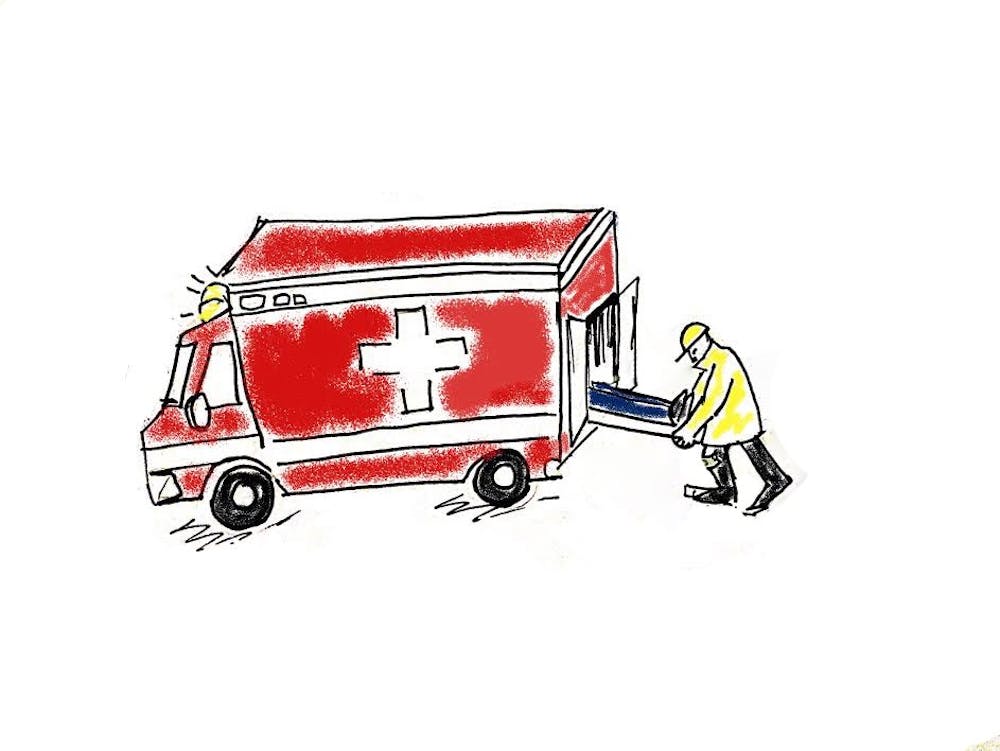On weekend nights, when an ambulance with blaring siren and flashing lights rushes down Spruce Street, pedestrians who witness this fleeting vehicle might assume that the ambulance is heading to the frat houses on campus. Unbeknownst to them, a group of Pennsylvania state–certified emergency medical technicians (EMT) are probably already there. These bicycle–riding EMTs in red shirts represent Penn’s Medical Emergency Response Team (MERT). They are full–time students, and they do more than just emergency medical service.
To probe into the backscenes of Penn’s student–run medical force, I spent a Saturday overnight shift at MERT’s headquarters in the Butcher basement of Ware College House in the Quad.
With a squad room cleaning schedule and a semesterly calendar pasted onto the wall, the study room is where MERT EMTs do their homework when they are not on calls. A large Emergency Preparedness Sector Map is also hanging in the room, since MERT EMTs need to know Penn’s map like the back of their hands. They should know the difference between McNeil Building and the McNeil Center for Early American Studies, between Hill Pavilion and Hill College House. With portable radios by their side, they are expected to respond immediately to calls, even if they are in the middle of watching a movie or taking a nap. David Gordon (C '19), Chief of MERT, says, “EMTs are always ready to respond.”
In addition to the study space, there are four other rooms in MERT’s headquarters: one lounge room that has a TV and cozy couches, a bunk room for EMTs on duty to rest, an equipment storage room, and a bicycle storage and repair room.
The layout of these rooms is the same as that of the freshmen dorms above—a square–shape room with a water sink and a large window. And yet, the equipment stored in MERT’s headquarters could not be more different than the textbooks for freshman seminars and boxes of ramen that serve as the freshman survival pack. MERT's equipment is crucial to saving lives. As a licensed quick response agency, MERT carries the full scope of basic life support medical equipments, such as AEDs, naloxone, and pulse oximetry. Each of their five bikes are loaded with equipment that weighs up to 50 pounds, comparable to what you would find in an ambulance.
MERT operates Monday through Friday from 5 p.m. to 7 a.m. and 24 hours on weekends. When on–duty, MERT EMTs arrive 15–20 minutes before the shift to change into MERT uniforms: a red top labeled with Penn EMTs on the back, a pair of black pants, and special made shoes with waterproof material and thickened rubber soles that can better accommodate unforeseeable emergency situations. The crew members—usually 3–4 certified EMTs—would then do a roll call, check equipments on their bikes, and tell the University of Pennsylvania Police Department (UPPD) that they are ready to go.
Since its founding, Penn MERT’s website states that the group has responded to more than 5,000 calls in their almost 11 years of service, and the average response time is less than 5 minutes. There are currently 46 active EMTs in MERT.
David explains the process of calling MERT in clear procedures. When someone calls the Penn emergency number within the Penn Patrol Zone (43rd to 30th streets between Market and Baltimore), a dispatcher at the Division of Public Safety is connected, who will then dispatch MERT. Simultaneously, the Philadelphia Fire Department is dispatched, who will provide an ambulance if the situation demands one.
MERT’s goal is to take care of every person, and they are trained to deal with all medical situations. Anyone who reports an accident within the Penn Patrol Zone will be treated with first response medical services, not just members of the Penn community. MERT also does more than just emergency medical service, offering CPR classes to the community and collaborating with DPS on side–by–side dorm sprinkler demonstrations, which will take place on September 21.
When talking about MERT’s group culture, David says, “I have met some of my best friends on campus through MERT. [MERT] is not only for the community, but a community itself.” On Saturday night, a few MERT members were watching the movie 21 right before they were dispatched. A 2013–2014 photo album in MERT’s headquarters reveals memories shared amongst MERT members from having dinners to attending conferences to showing up at a once–then Senior’s graduation ceremony.
MERT members come from a wide range of academic backgrounds. Alongside the expected biology or pre–med students, there are MERT members who major in architecture, economics, religious studies, and nursing. Graduate and LPS students are also welcome to join.
Students who work for MERT are not paid, but gain value in their experience. Jai Patel (C '20) views MERT as complementary to his medical study, since it’s “not parallel with any labs or lectures” and gives him opportunities to interact with patients. David agrees, “There’s so much this community can teach on how to be confident, how to communicate with patients, and how to deal with emergencies.”
At the center of MERT’s website is its emergency number. The idea behind this setup, as John explains, is that people can easily find the number at any given time. MERT is committed to prioritizing patients’ needs and extending its help to every individual in the Penn Patrol Zone, not just drunk students at frat parties on a Saturday night.
An earlier version of this article stated that students who work for MERT are Emergency Medical Trainees, instead of Emergency Medical Technicians. 34th Street regrets this error.

